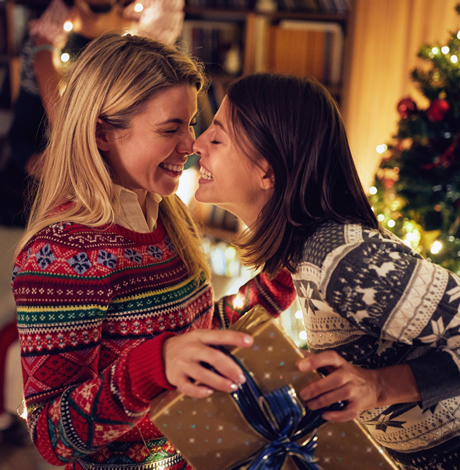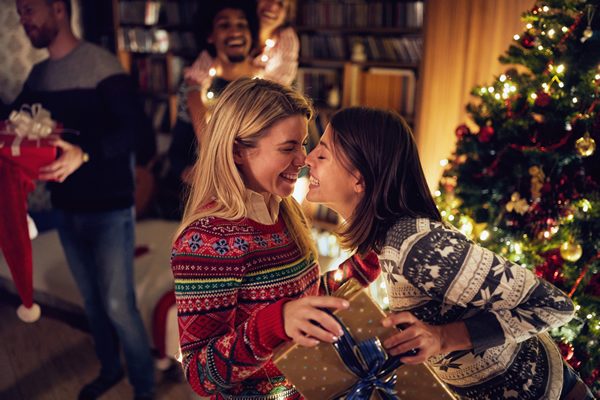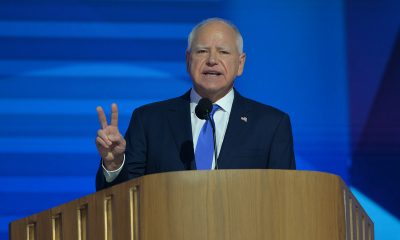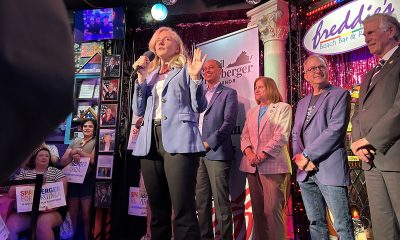a&e features
Bah, humbug! Pandemic exacerbates holiday blues
Take steps to reduce, even eliminate, seasonal stress


Feasting on turkey with your family. Hanukkah Harry. Santa. “A Christmas Carol.” Sugar Plum fairies. Lighting candles to celebrate Kwanzaa. Ringing in the New Year!
It’s the holidays! Happy! Happy!
Not so much. Especially during the pandemic, and if you’re queer.
There are always holiday naysayers who dread Thanksgiving, loathe “It’s a Wonderful Life” and shout, “Bah, humbug!”
Yet, in the pandemic, many of us have the “holiday blues” more acutely than we did in past holiday seasons, psychologists and LGBTQ advocates told the Blade in interviews.
The term “holiday blues” is bandied about often. Yet, its meaning isn’t always clear. The “holiday blues” isn’t a mental illness, said Elaine Rodino, a psychologist in private practice in State College, Pa.
“It’s not a diagnosable ailment. It’s a feeling of malaise,” she said, “of anxiety – of discomfort that occurs during the holidays.”
But just because the “holiday blues” isn’t pathological, doesn’t mean that feelings of anxiety, stress and sadness during the holidays aren’t painful.
Our holiday stress is nearly always related to our childhood experiences, Rodino said. “For example, if we grew up with an alcoholic parent, we’ll recall how that parent would ruin the holidays,” she said, “it would start out fine. But, by the end of the night, the parent would be drunk, hostile – angry.”
On the other hand, we may recall our childhood holidays as having been absolutely perfect. “You might remember that your Mom baked 300 cookies. They were the best in the world,” Rodino said. “You’ll feel guilty because your present doesn’t match up to your memories of past perfection.”
The pandemic with its restrictions, illness and financial losses adds an added layer of stress to the holidays, especially for the LGBTQ community and other vulnerable groups.
“One way to deal with holiday stress is to volunteer,” Rodino advised, “to soup kitchens. Include vulnerable people in your Zoom events.”
Don’t be intimidated by past holiday rituals. “Create your own traditions,” Rodino said. “If we did everything like people did in the past, we’d do things like they did in the Middle Ages.”
From Hallmark movies to endless holiday music playlists to ads showing families merrily gathering before the fire, we’re led to expect that the holidays will be filled with happiness and togetherness.
We experience the “holiday blues” when our holidays don’t live up to these cultural expectations, said Nicholas Grant, a clinical psychologist and president elect of GLMA (Health Professionals Advancing LGBTQ Equality).
In addition to this stress, many LGBTQ people experience overt or subtle homophobia or transphobia when they gather with their family of origin for the holidays, Grant, who is queer, said.
The pandemic has added layers to holiday loneliness and insecurity.
You can take steps to reduce, if not totally eliminate, holiday stress, Grant added. “Use technology like Zoom to see family and friends who you can’t see in person,” he said.
Be proactive about who you want to see over the holidays, Grant advised. If you feel that connecting with someone in your family would be stressful for you, limit your time with them. “My Dad and I have no relationship as of this year,” Grant said, “because of his behavior and politics. It’s brought up for me: how do I want to experience this holiday season?”
Doing something that’s enjoyable to you and in line with your values is a great way to cope with the holidays, he added, “whether it’s writing poetry, riding a bike, baking bread or volunteering.”
For information on coping with the “holiday blues” or finding a therapist, Grant recommends Psychology Today, psychologytoday.com.
Most cisgender, heterosexual people who go home for the holidays, even if they are of a different faith, are culturally similar to their family of origin, said psychologist Keely Kolmes. “That’s not true for all queer folks,” said Kolmes who identifies as nonbinary. “Their families often direct micro aggressions at them, leaving them feeling isolated.”
Sometimes, homophobia or transphobia can be physically unsafe. But, even subtle micro aggressions, such as a snide comment on a celeb coming out, can be hurtful, they added. (Kolmes uses the pronouns they/them.)
“I advise clients when they go home for the holidays to have an escape plan with a friend or trusted family member,” Kolmes said, “for where they can go or what they can do if things go wrong.”
LGBTQ people seeking support (such as support groups or friendly religious events) during the holidays should contact LGBTQ centers and queer-friendly houses of worship in their communities, Kolmes advised.
We often hear this overwhelming, anti-LGBTQ religious voice, said Michael Vazquez, HRC Religion & Faith Program Director. “Yet, the intensity of that voice is disproportionate,” Vazquez added, “the overwhelming majority of American people of faith are welcoming and affirming of LGBTQ people.”
“Going home – being with the family for Hanukkah, Christmas, Kwanzaa – it’s important to remember,” he said, “it’s not antithetical to be both LGBTQ and a person of faith.” (For more information, visit hrc.org/resource/religion-faith.)
Many queer people (especially trans people) are struggling to survive during the pandemic, said Anneliese Singh, a counseling psychologist and chief diversity officer at Tulane University. “I think, too, with this election, during the holidays, many of us are going to have to set boundaries with those of our families who supported Trump,” Singh, who identifies as gender queer, said.
Sometimes Trump supporters separate their votes for Trump from their love for their queer loved ones, she added, “but, for us, a vote for Trump means a vote against ourselves.”
LGBTQ people should reclaim their religious traditions – from Kwanzaa rituals to Advent services, Singh said.
“Another way to move through the ‘holiday blues,’‘ she added, “is to have a daily set of gratitude boxes. Not cheesy gratitude. But gratitude that we’re queer and survived and thrived.”
Singh and her partner connected 10 years ago during the holidays.
“Christmas Eve is a special night for us,” she said, “it’s when we first got together. Every Christmas we think: How do we want to celebrate our relationship?”
Even before the pandemic, the holidays were difficult for queer and trans youth, said Adalphie Johnson, director of programs for SMYAL (Supporting and Mentoring Youth Advocates and Leaders). “Some are homeless. Some are in unsafe spaces,” she said, “they’re not able to express themselves as far as clothing, etc.”
Youth are often unable to bring their partners to family holiday gatherings. “The pandemic with its social distancing adds to the social isolation,” Johnson said.
SMYAL is working to create safe virtual holiday events for youth, said Johnson, who is queer. “We’re sending out gift cards so they can order food and virtually eat together,” she added. “We ensure that the young people have all the fixings and trimmings.”
When young people get together with their families, SMYAL advises them to have one or two people they can call or text if they feel unsafe.
During her youth, “the most difficult thing during the holidays was that I didn’t know who in my family – like my aunts – would accept my girlfriend,” Johnson said.
(For more information and resources, visit: smyal.org, thetrevorproject.org, gsanetwork.org and glsen.org)
The holidays can be hard for everyone of every age, including LGBTQ elders. Older LGBTQ people are more likely to feel lonely during the holidays because they’re more likely to live alone, be single and not have children, said Bill Gross, assistant director of special programs for SAGE.
SAGE’s services for older LGBTQ people range from a friendly visitor program to a hotline run by volunteers trained in crisis counseling. The hotline, open 24/7, 365 days a year, including the holidays, provides free support in English and Spanish (with translation services in 180 languages). (For information, visit sageusa.org.)
Richard Daniels, a performer, is a member of SAGE’s New York City affiliate. Daniels was in “Help,” a play by poet and writer Claudia Rankine. The play shut down after two previews because of COVID. “The holidays will be no different. We’ll still be in quarantine,” Daniels said.
Daniels and his husband love Thanksgiving. “We’re Jewish. We don’t do much for Hanukkah or Christmas,” he said, “but Thanksgiving’s the one holiday where we love to get together with people — family, friends, out-of-town visitors — people with nowhere to go.”
“We still have much to be grateful for,” Daniels added, “we don’t drink. But we’d love to share a piece of pie on Zoom on Thanksgiving.”

a&e features
Queer highlights of the 2026 Critics Choice Awards: Aunt Gladys, that ‘Heated Rivalry’ shoutout and more
Amy Madigan’s win in the supporting actress category puts her in serious contention to win the Oscar for ‘Weapons’

From Chelsea Handler shouting out Heated Rivalry in her opening monologue to Amy Madigan proving that horror performances can (and should) be taken seriously, the Critics Choice Awards provided plenty of iconic moments for queer movie fans to celebrate on the long road to Oscar night.
Handler kicked off the ceremony by recapping the biggest moments in pop culture last year, from Wicked: For Good to Sinners. She also made room to joke about the surprise hit TV sensation on everyone’s minds: “Shoutout to Heated Rivalry. Everyone loves it! Gay men love it, women love it, straight men who say they aren’t gay but work out at Equinox love it!”
The back-to-back wins for Jacob Elordi in Frankenstein and Amy Madigan in Weapons are notable, given the horror bias that awards voters typically have. Aunt Gladys instantly became a pop culture phenomenon within the LGBTQ+ community when Zach Cregger’s hit horror comedy released in August, but the thought that Madigan could be a serious awards contender for such a fun, out-there performance seemed improbable to most months ago. Now, considering the sheer amount of critics’ attention she’s received over the past month, there’s no denying she’s in the running for the Oscar.
“I really wasn’t expecting all of this because I thought people would like the movie, and I thought people would dig Gladys, but you love Gladys! I mean, it’s crazy,” Madigan said during her acceptance speech. “I get [sent] makeup tutorials and paintings. I even got one weird thing about how she’s a sex icon also, which I didn’t go too deep into that one.”
Over on the TV side, Rhea Seehorn won in the incredibly competitive best actress in a drama series category for her acclaimed performance as Carol in Pluribus, beating out the likes of Emmy winner Britt Lower for Severance, Carrie Coon for The White Lotus, and Bella Ramsey for The Last of Us. Pluribus, which was created by Breaking Bad’s showrunner Vince Gilligan, has been celebrated by audiences for its rich exploration of queer trauma and conversion therapy.
Jean Smart was Hack’s only win of the night, as Hannah Einbinder couldn’t repeat her Emmy victory in the supporting actress in a comedy series category against Janelle James, who nabbed a trophy for Abbott Elementary. Hacks lost the best comedy series award to The Studio, as it did at the Emmys in September. And in the limited series category, Erin Doherty repeated her Emmy success in supporting actress, joining in yet another Adolescence awards sweep.
As Oscar fans speculate on what these Critics Choice wins mean for future ceremonies, we have next week’s Golden Globes ceremony to look forward to on Jan. 11.
a&e features
Looking back at the 10 biggest A&E stories of 2025
‘Wicked,’ Lady Gaga’s new era, ‘Sexy’ Bailey and more

Although 2025 was a year marked by countless attacks on trans rights and political setbacks, the year also saw brilliant queer artists continuing to create art. From Cannes and Sundance Award winners now vying for Oscar consideration to pop icons entering new stages of their careers, queer people persevered to tell their stories through different media.
With the state of the world so uncertain, perhaps there’s no more vital time to celebrate our wins, as seen through some of this year’s top pop culture moments. While there’s no collection of 10 stories that fully encompass “the most important” news, here are some events that got the gays going:
10. ‘Mysterious Gaze of the Flamingo’ wins big at Cannes

The Cannes Film Festival has become a crucial start for films hoping to make their way to the Oscars, and first-time director Diego Céspedes won the top Un Certain Regard prize for his intimate western “The Mysterious Gaze of the Flamingo.” The film is set in the ‘80s and is intended as an allegory for the AIDS epidemic. Seeing a film that unpacks vital queer history win one of the most coveted awards at Cannes has been a huge point of pride in the independent filmmaking community.
Since the film bowed at Cannes, it has been selected as Chile’s Oscar entry in the Best International Feature race. Speaking with The Blade during the film’s AFI Fest run in October, Céspedes said: At first, I was kind of scared to have this campaign position in the times that we’re living [in] here. But at the same time, I think the Oscars mean a huge platform — a huge platform for art and politics.”
9. ‘The Last of Us’ returns for an even gayer season 2
While the first season of The Last of Us gave us one of TV’s most heartbreaking queer love stories in the episode “Long, Long Time,” Season 2 doubled down on its commitment to queer storytelling with the blossoming relationship between Ellie (Bella Ramsey) and Dina (Isabela Merced). The show expanded on the pair’s relationship in the original video game, making it perhaps the central dynamic to the entire season. That unfortunately came with more homophobic backlash on the internet, but those who checked out all the episodes saw a tender relationship form amid the show’s post-apocalyptic, often violent backdrop. For their performance, Ramsey was once again nominated for an Emmy, but Merced deserved just as much awards attention.
8. ‘Emilia Pérez’ sparks controversy
Jacques Audiard’s genre-bending trans musical “Emilia Pérez” proved to be an awards season juggernaut this time last year, winning the Golden Globe for Best Musical/Comedy. But when the lead star Karla Sofia Gascón’s racist, sexist, and homophobic old tweets resurfaced, the film’s Oscar campaign became a tough sell, especially after Netflix had tried so hard to sell Emilia Pérez as the “progressive” film to vote for. Mind you, the film had already received significant backlash from LGBTQ+ audiences and the Mexican community for its stereotypical and reductive portrayals, but the Gascón controversy made what was originally just social media backlash impossible to ignore. The only person who seemed to come out of the whole debacle unscathed was Zoe Saldaña, who won the Oscar for Best Supporting Actress over Ariana Grande.
7. ‘Sorry, Baby’ establishes Eva Victor as major talent
Back in January at the Sundance Film Festival, Eva Victor (known by many for her brand of sketch comedy) premiered their directorial debut “Sorry, Baby” to rave reviews, even winning the Waldo Salt Screening Award. Victor shadowed Jane Schoenbrun on the set of “I Saw the TV Glow,” and seeing Victor come into their own and establish such a strong voice immediately made them one of independent cinema’s most exciting new voices. A memorable scene in the film sees the main character, Agnes (played by Victor), struggling to check a box for male or female, just one example of how naturally queerness is woven into the fabric of the story.
Most recently, Victor was nominated for a Golden Globe for her performance in the film, and she’s represented in a category alongside Jennifer Lawrence (“Die My Love”), Jessie Buckley (“Hamnet”), Julia Roberts (“After the Hunt”), Renate Reinsve (“Sentimental Value”) and Tessa Thompson (“Hedda”). The film also received four Independent Spirit Award nominations overall.
6. Paul Reubens comes out in posthumous doc

While Paul Reubens never publicly came out as gay before passing away in 2023, the two-part documentary “Pee-wee as Himself” premiered back in May on HBO Max, giving the legendary comedian a chance to posthumously open up to the world. Directed by Matt Wolf, the documentary explores how Reubens found his alter ego Pee-Wee Herman and why he kept his private life private.
The documentary won an Emmy in the Outstanding Documentary or Nonfiction Special category and remains one of the most critically acclaimed titles of the year with a 100% Rotten Tomatoes score. Also worth noting, the National Geographic documentary Sally told the posthumous coming out story of Sally Ride through the help of her long-time partner, Tam O’Shaughnessy.
5. Lady Gaga releases ‘Mayhem’
Lady Gaga entered a new phase of her musical career with the release of Mayhem, her seventh album to date. From the frenzy-inducing pop hit Abracadabra to the memorable Bruno Mars duet featured on “Die With a Smile,” seeing Gaga return to her roots and make an album for the most die-hard of fans was especially rewarding after the underwhelming film releases of “House of Gucci” and “Joker: Folie à Deux.” Gaga has been touring with The Mayhem Ball since July, her first arena tour since 2018. She even extended her tour into 2026 with more North American dates, so the party isn’t stopping anytime soon. And Gaga is even set to make an appearance next May in “The Devil Wears Prada 2.”
4. Cynthia Erivo, Ariana Grande perform at the Oscars

While “Wicked: For Good” didn’t quite reach the heights of the first film, we will forever have Cynthia Erivo and Ariana Grande’s breathtaking live performance that opened the 97th Academy Awards. The pair sang a rendition of “Over the Rainbow,” “Home,” and “Defying Gravity,” paying proper homage to the original 1939 “Wizard of Oz.” Even non-Wicked fans can’t deny how magical and brilliantly staged this performance was. With both Erivo and Grande up for acting Oscars last year, they’re hoping to repeat success and make history with consecutive nominations. Either way, let’s hope there’s another live performance in the making, especially with two new original songs (The Girl in the Bubble and No Place Like Home) in the mix.
3. Indya Moore speaks out against Ryan Murphy
Indya Moore has consistently used social media as a platform for activism, and in September, posted a 30-minute Instagram live speaking out against “Pose” co-creator Ryan Murphy. Moore claimed that Murphy wasn’t being a true activist for trans people. “Ryan Murphy, we need you to do more. You need to address the racism, the violence, and the targeting of people on your productions, Ryan Murphy. You do need to make sure trans people are paid equally. Yes, Janet did the right thing,” Moore said. Murphy was also back in the headlines this year for the critically panned “All’s Fair” and the controversial “Monster: The Ed Gein Story” starring Laurie Metcalf and Charlie Hunnam.
2. Cole Escola wins Tony for Best Leading Actor
Few pop culture moments this year brought us together more than Cole Escola winning a Tony award for “Oh, Mary!” the Broadway show they created, wrote and starred in (we love a triple threat!) Escola made history by becoming the first nonbinary person to win a Tony in the leading actor category, and seeing them excitedly rush to the stage wearing a Bernadette Peters-inspired gown instantly became a viral social media moment.
The cherry on top of Escola’s major moment is the recent news that they are writing a Miss Piggy movie with Jennifer Lawrence and Emma Stone producing — news that also broke the internet for the better. We cannot wait!
1. Jonathan Bailey makes gay history as ‘Sexiest Man Alive’

The same year as his on-screen roles in blockbusters “Jurassic World Rebirth” and “Wicked: For Good,” Jonathan Bailey made history as the first openly gay man to be named People magazine’s “Sexiest Man Alive.” The fact that it took 40 years for an openly gay man to earn the title is a signifier of how far we still have to go with queer representation, and seeing Bailey celebrated is just one small step in the right direction.
“There’s so many people that want to do brilliant stuff who feel like they can’t,” he told PEOPLE, “and I know the LGBT sector is under immense threat at the moment. So it’s been amazing to meet people who have the expertise and see potential that I could have only dreamed of.” In 2024, Bailey founded the charity titled The Shameless Fund, which raises money for LGBTQ+ organizations.
a&e features
Your guide to D.C.’s queer New Year’s Eve parties
Ring in 2026 with drag, leather, Champagne, and more

With Christmas in the rear view mirror, we can turn our attention to ringing in a much-anticipated New Year with a slew of local LGBTQ parties. Here’s what’s on tap.
Pitchers
This spacious Adams Morgan bar is hosting the “Pitchers’ Perfect New Year’s Eve.” There will be a midnight Champagne toast, the ball drop on the big screens, and no cover, all night long. The bar doesn’t close until 4 a.m., and the kitchen will be open late (though not until close). All five floors will be open for the party, and party favors are promised.
Trade
D.C.’s hottest bar/club combo is leaning into the Shark motif with its NYE party, “Feeding Frenzy.” The party is a “glitterati-infused Naughty-cal New Year’s Even in the Shark Tank, where the boats are churning and the sharks are circling.” Trade also boasts no cover charge, with doors opening at 5 p.m. and the aforementioned Shark Tank opening at 9 p.m.. Four DJs will be spread across the two spaces; midnight hostess is played by Vagenesis and the two sea sirens sensuously calling are Anathema and Justin Williams.
Number Nine
While Trade will have two DJs as part of one party, Number Nine will host two separate parties, one on each floor. The first floor is classic Number Nine, a more casual-style event with the countdown on TVs and a Champagne midnight toast. There will be no cover and doors open at 5 p.m. Upstairs will be hosted by Capital Sapphics for its second annual NYE gathering. Tickets (about $50) include a midnight Champagne toast, curated drink menu, sapphic DJ set by Rijak, and tarot readings by Yooji.
Crush
Crush will kick off NYE with a free drag bingo at 8 p.m. for the early birds. Post-bingo, there will be a cover for the rest of the evening, featuring two DJs. The cover ($20 limited pre-sale that includes line skip until 11 p.m.; $25 at the door after 9 p.m.) includes one free N/A or Crush, a Champagne toast, and party favors (“the legal kind”). More details on Eventbrite.
Bunker
This subterranean lair is hosting a NYE party entitled “Frosted & Fur: Aspen After Dark New Year’s Eve Celebration.” Arriety from Rupaul Season 15 is set to host, with International DJ Alex Lo. Doors open at 9 p.m. and close at 3 p.m.; there is a midnight Champagne toast. Cover is $25, plus an optional $99 all-you-can-drink package.
District Eagle
This leather-focused bar is hosting “Bulge” for its NYE party. Each District Eagle floor will have its own music and vibe. Doors run from 7 p.m.-3 a.m. and cover is $15. There will be a Champagne toast at midnight, as well as drink specials during the event.
Kiki, Shakiki
Kiki and its new sister bar program Shakiki (in the old Shakers space) will have the same type of party on New Year’s Eve. Both bars open their doors at 5 p.m. and stay open until closing time. Both will offer a Champagne toast at midnight. At Kiki, DJ Vodkatrina will play; at Shakiki, it’ll be DJ Alex Love. Kiki keeps the party going on New Year’s Day, opening at 2 p.m., to celebrate Kiki’s fourth anniversary. There will be a drag show at 6 p.m. and an early 2000s dance party 4-8 p.m.
Spark
This bar and its new menu of alcoholic and twin N/A drinks will host a NYE party with music by DJ Emerald Fox. Given this menu, there will be a complimentary toast at midnight, guests can choose either sparkling wine with or without alcohol. No cover, but Spark is also offering optional wristbands at the door for $35 open bar 11 p.m.-1 a.m. (mid-shelf liquor & all NA drinks).
-

 National4 days ago
National4 days agoWhat to watch for in 2026: midterms, Supreme Court, and more
-

 Colombia5 days ago
Colombia5 days agoBlade travels to Colombia after U.S. forces seize Maduro in Venezuela
-

 Minnesota5 days ago
Minnesota5 days agoTim Walz drops out of Minn. governor’s race
-

 Virginia5 days ago
Virginia5 days agoLGBTQ groups to join Spanberger inaugural parade




















